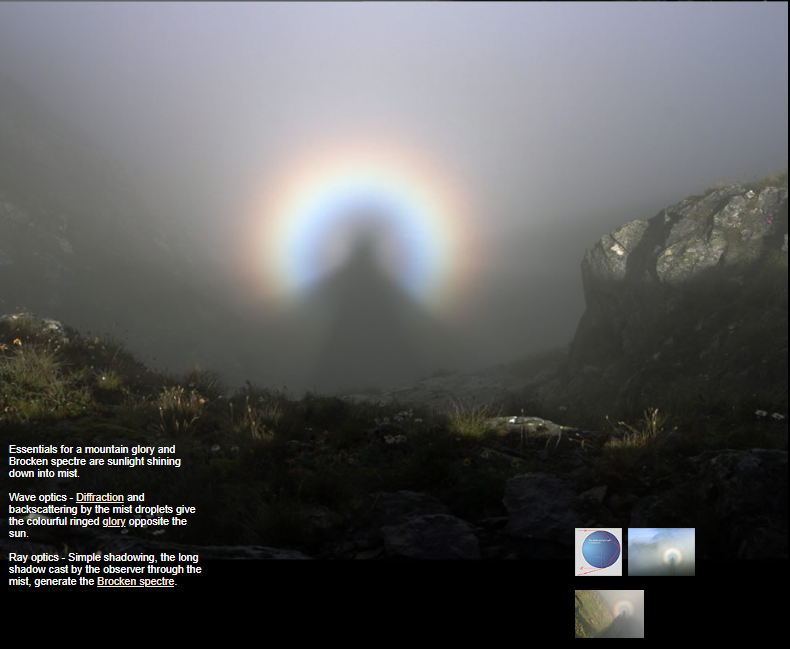Mountain Glory, Romania
Mountain Glory: A Spectacular Phenomenon in Romania
When it comes to atmospheric optics, Romania's Fagaras Mountains offer a breathtaking spectacle known as the Mountain Glory. This captivating phenomenon, captured in stunning images by photographer Radu Gherase, showcases the interplay of sunlight, mist, and the observer's shadow. In this article, we will delve into the science behind this natural marvel and explore the two optical effects that contribute to its formation: the colorful ringed glory and the eerie Brocken spectre.
The Essentials for a Mountain Glory and Brocken Spectre
To witness a Mountain Glory in Romania, two key elements must come together: sunlight and mist. As sunlight penetrates the mist, both wave optics and ray optics come into play, creating the mesmerizing display. Let's take a closer look at each of these optical phenomena:
Wave Optics: The Colorful Ringed Glory
In wave optics, the mist droplets act as tiny diffraction and backscattering surfaces. As sunlight passes through these droplets, it undergoes diffraction, resulting in a colorful ringed glory that appears opposite the sun. The diffraction causes the light to spread out and interfere constructively and destructively, producing distinct rings of colors. The angle at which the glory is observed depends on the size of the mist droplets and their distribution.
Ray Optics: The Eerie Brocken Spectre
On the other hand, ray optics relies on simple shadowing effects. When an observer stands in front of the mist, their shadow is cast onto the mist droplets. As sunlight shines from behind the observer, their long shadow is projected onto the mist, creating a giant figure that appears magnified and distorted. This phenomenon is known as the Brocken spectre, named after the Brocken mountain in Germany where it was first observed.
The Science Behind the Phenomena
The Mountain Glory and the Brocken spectre can be explained by the principles of wave and ray optics. Here's a breakdown of the science behind each phenomenon:
Wave Optics: Diffraction and Backscattering
- Sunlight enters the mist, encountering countless mist droplets suspended in the air.
- The mist droplets act as tiny diffraction surfaces, causing the light to spread out and form rings of colors.
- The different colors observed in the glory are a result of constructive and destructive interference between the diffracted light waves.
- The size and distribution of the mist droplets determine the angle at which the glory is observed.
Ray Optics: Simple Shadowing
- As sunlight shines from behind the observer, their shadow is cast onto the mist droplets.
- The observer's long shadow is projected onto the mist, appearing magnified and distorted.
- The magnification occurs due to the observer's position relative to the light source and the mist.
- The eerie appearance of the Brocken spectre adds an extra layer of intrigue to the Mountain Glory phenomenon.
Experiencing the Mountain Glory in Romania
To witness the awe-inspiring Mountain Glory in Romania, one must venture to the Fagaras Mountains. These majestic peaks provide a stunning backdrop for this atmospheric spectacle. Here are a few tips to enhance your experience:
- Choose a day with misty conditions and ample sunlight for the best chances of observing the Mountain Glory.
- Position yourself so that the sun is behind you, casting your shadow onto the mist.
- Look opposite the sun to spot the colorful ringed glory created by wave optics.
- Be patient and observant, as these phenomena may appear and disappear rapidly due to changing atmospheric conditions.
The Fascination of Atmospheric Optics
The Mountain Glory in Romania serves as a captivating reminder of the wonders of atmospheric optics. These natural phenomena highlight the intricate interplay between light, mist, and the observer's position. By understanding the underlying science, we can appreciate the beauty and complexity of these optical effects.
As we gaze upon the ethereal Mountain Glory and the eerie Brocken spectre, we are reminded of the vast mysteries that surround us in the natural world. The interplay of wave and ray optics creates moments of astonishment and wonder, leaving us in awe of the captivating phenomena that unfold before our eyes.
So, if you find yourself in Romania's Fagaras Mountains on a misty day, take a moment to witness the Mountain Glory and immerse yourself in the captivating world of atmospheric optics. It's an experience that will leave you with lasting memories and a newfound appreciation for the hidden wonders that exist all around us.

Two Romanian Glories pictured by Radu Gherase in the Fagaras Mountains. Image �Radu Gherase, shown with permission.

Essentials for a mountain glory and Brocken spectre are sunlight shining down into mist.
Wave optics - Diffraction and backscattering by the mist droplets give the colourful ringed glory opposite the sun.
Ray optics - Simple shadowing, the long shadow cast by the observer through the mist, generate the Brocken spectre.
Note: this article has been automatically converted from the old site and may not appear as intended. You can find the original article here.
Reference Atmospheric Optics
If you use any of the definitions, information, or data presented on Atmospheric Optics, please copy the link or reference below to properly credit us as the reference source. Thank you!
-
<a href="https://atoptics.co.uk/blog/mountain-glory-romania/">Mountain Glory, Romania</a>
-
"Mountain Glory, Romania". Atmospheric Optics. Accessed on April 19, 2024. https://atoptics.co.uk/blog/mountain-glory-romania/.
-
"Mountain Glory, Romania". Atmospheric Optics, https://atoptics.co.uk/blog/mountain-glory-romania/. Accessed 19 April, 2024
-
Mountain Glory, Romania. Atmospheric Optics. Retrieved from https://atoptics.co.uk/blog/mountain-glory-romania/.